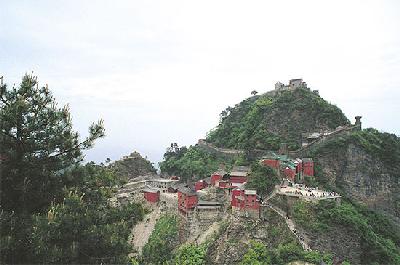Ancient Architectural Complex on Wudang Mountain
Wudang Mountain, also known as Taihe Mountain, is located in Danjiangkou City, northwest Hubei Province. It is not only a famous Taoist mountain and birthplace of the art of Wudang boxing but is also known as the site of an ancient architectural complex both at home and abroad. in 1994 it was listed as a world cultural heritage site.
Wudang Mountain, which has a circumference of 400 kilometers has 72 peaks, 36 rocks, 24 ravines, nine springs, eight palaces and two Taoist temples. Tianzhu (Column) Peak, the main peak, rises 1,612 meters above sea level, like a column supporting the sky, and is famous for its uniqueness, silence and beauty. On the mountain there are several thousand cultural relics from the Yuan, Ming and other historical periods as well as a huge Taoist architectural complex. The solemn ancient buildings are well ordered, symmetrical and are spaced so that an echo occurs between them. The complex was started in 1412, the 10th year of the reign of Emperor Yongle of the Ming Dynasty, and was completed 12 years later. It extends 70 kilometers from Jingle Palace in Gujunzhou City to Golden Hall at the top of Tianzhu Peak. There are eight palaces, two Taoist temples, 36 nunneries, 72 temples on cliffs, 39 bridges, 12 pavilions and 10 ancestral temples. The main tourist spots are Xuanyue Gate, Yuanhe Taoist Temple, Yuzhen Palace, Yuxu Palace, Mozhen Well, Fuzhen Taoist Temple, Zixiao Palace, Southern Rock, Taihe Palace and Golden Hall. Two of them, Xixiao Palace and Golden Hall have been placed under state protection.
Zixiao Palace is one of the buildings that is still intact and is located at the foot of Zhanqi Peak, which is northeast of Tianzhu Peak. It was built in 1413, the 11th year of the reign of the Ming Emperor Yongle. The palace includes the Dongtian Gate, Dragon and Tiger Hall, Xunbei Stele Pavilion, Shifangzhang, Zixiao Hall and Parents Hall. The five-bay Zixiao Hall, the main building, was built on a three-level terrace; it is double-eaved, nine-ridged and has green tiles and red walls.
The Golden Hall, or Golden Crown, is situated on top of Tianzhu Peak and was built in 1416, the 14th year of the reign of the Ming Emperor Yongle. It is 5.54 meters high, 5.8 meters wide and 4.2 meters long and imitates the appearance of a timber structure. The tiles, rafters, ridgepoles, beams and gates are bronze and it was built on a granite base; it weighs more than 80 tons. Its double eaves rise up and on the ridges there are immortals and animals. The hall demonstrates well-developed artistic skills in casting, decorating and gold-plating and it is one of the best known Taoist buildings on the mountain.
Before you enter the hall you have to pass through Zijin City, which has a city wall 1.5 kilometers long, built from 500-kilogram rectangular stone slabs. The wall has four carved gates. Golden Hall is the best place to view the sunrise in the morning and the sea of clouds in the evening. It is included in the UNESCO world heritage list in 1994.
Source: http://old.cnta.gov.cn